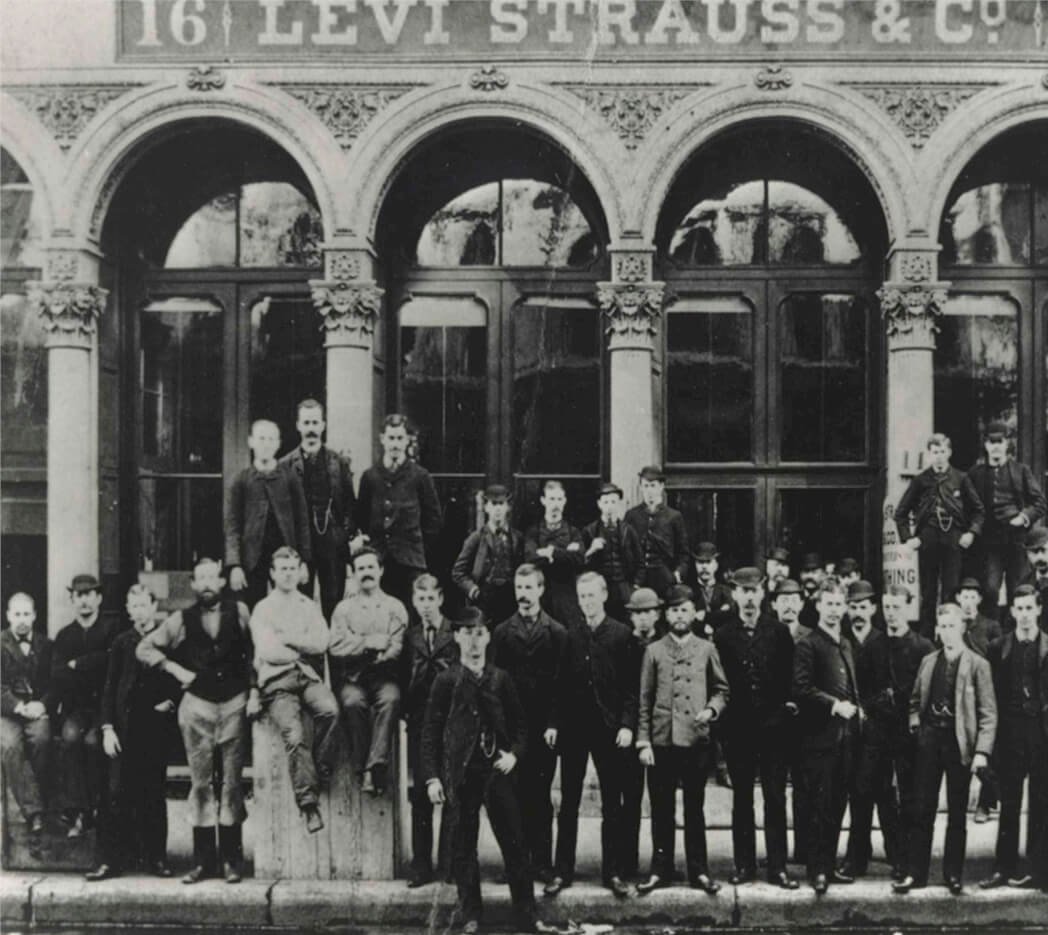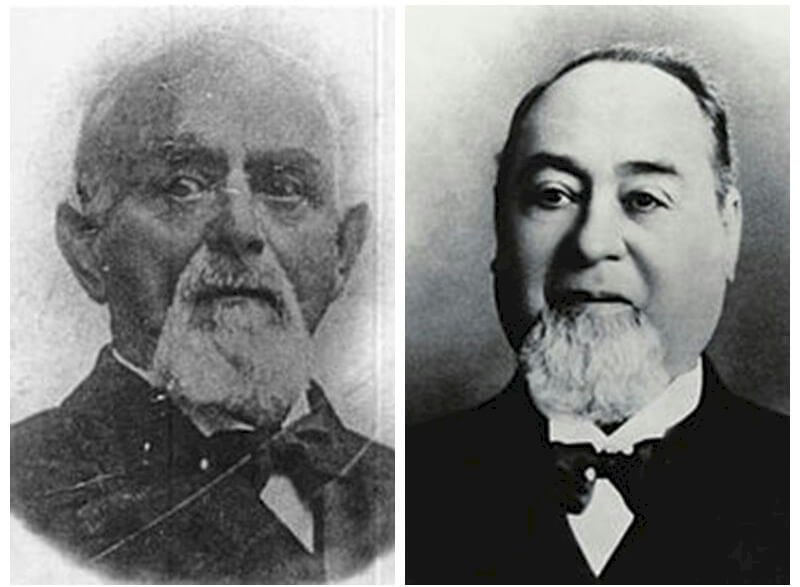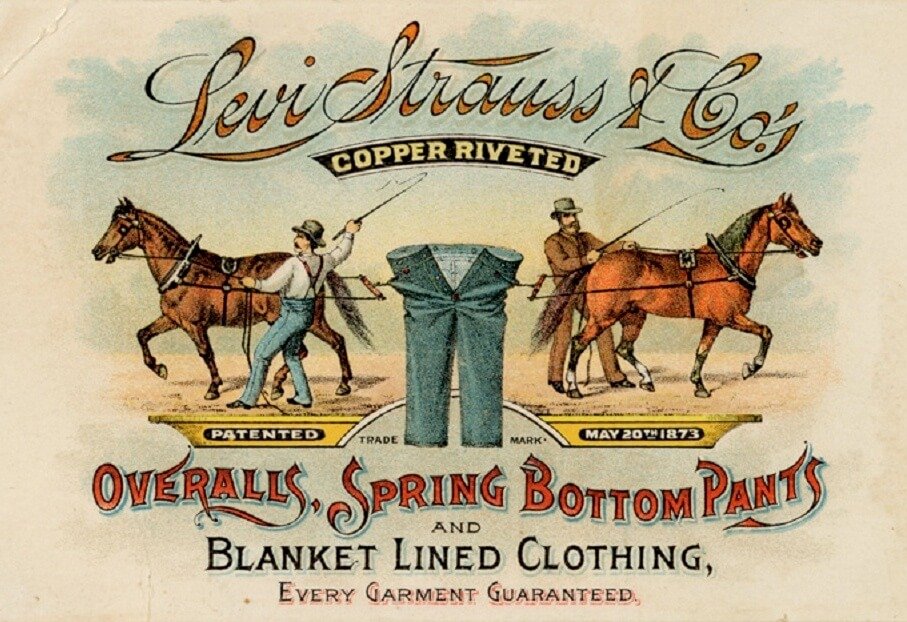Let’s take a look at the Levi Logo and some history behind the clothing company.
The California gold rush in 1848 lured several workers. If you’re one of the 300,000 people, what service would you have rendered to become prosperous? Levi Strauss and Jacob Davis were part of the people who saw a massive opportunity during this industrial era.
While some people went to San Francisco to work as laborers, others supplied them with food and tools. But Levi and Jacob team–up to supply the workers with overalls. Today, we called them jeans, and the inventor made them from denim fabrics.
The Levi fabric is sturdy and well–stitched to withstand the demanding working conditions. These overalls became popular and profitable that others have to imitate them. The owners attached a red label to the back pocket to help customers differentiate them.
The Levi’s clothing brand has a celebrated signature logo. It uses a red and white hue scheme: The red forms the background color, and the white took care of the letters. The name appears in uppercase letters except for the letter—e. This classic Levi logo design resembles a batwing.
The Levi’s logo is a familiar label in the fashion world. For over 15 decades, the laudable mark has become synonymous with denim, quality, durability, style, and fashion. The logo is a friendly legend on social mediums, digital platforms, merchandise, and print outlets.
Levi’s is the world’s manufacturer of pants, and it’s well–known for its famous blue jeans. Some other garments from the brand are jackets, hats, belts, skirts, and slacks.
Levi’s Logo Evolution
For nearly 150 years, Levi’s has had about eight unique redesigns. Some of these updated designs were average, yet others admirable. Let’s look at its logo journey in brief.
1853 to 1892—The Maiden Wordmark
The company’s first official logo was a wordmark logotype. It comprises a narrow rectangle with the owner’s name—Levi Strauss in all–caps. The logo also contains the symbol – & and Co. At the extreme ends are the numbers—16 and 14. The symbol had a monochrome color scheme.
1892 to 1925—The Two–Horse Emblem
From this period, Levis adopted a picture logo. People famously called it “The Two Horse Brand.” The emblem shows two horses and their owners pulling jeans in the opposite direction. Above the horses and their riders is the brand’s name. It also included other inscriptions and the date it patents its rivet. This logo appealed to the literates, illiterates, and non–native English speakers. It came in a black and white color palette.

1925 to 1929—The Red Levi’s Insignia
For four years, the clothing giant adopted a new logotype. The company went for a simple wordmark that spelled its name in bold red letters. These typefaces sat on a faint background with a black outline. It was a suitable replacement for the photo logo because the jeans had become famous.
1929 to 1943—The Blue & White Levi Logo
The company had its third update. This time, it opted for a thick white and blue modest wordmark signature. This version of the logo is a shortened form of the owner’s name. And it came with the tagline—America’s Finest Overall in all–caps. The designer fit the letterings on an orange rectangular frame.
1943 to 1949—The Dark Blue Levi Symbol
After 14 years, the company changed its logo design. It went for a yellow frame with the owner’s first name. The letters were uppercase, bold, and dark blue. It kept the tagline in caps—America’s Finest Overall in a light color.
1949 to 1954—The Red & White Levi Symbol
In 1949, the company redesigned its signature Levi logo. A red frame with a white uppercase, Levi’s, became the face of the brand. It was the period after the Second World War. The trademark contains other inscriptions and design elements.
1954 to 1969—The Vintage Levi Symbol
The company refined its previous logo: The red background became solid brighter. And its letters sharper and smooth. Below the brand’s name was the phrase—Vintage Clothing. It featured a simple and readable sans–serif font. All the letters in the logo were caps and white.
1969 to 2003—The Light Red Batwing Icon
The brand’s stylized logo came into existence. Levis termed it as the Batwing because it looks like a spreading bat wing. This famed logo comprises a bright red frame around the company’s name in white: The typefaces are all capital except the letter—e. The logo is sleek, minimalist, and versatile.
2003 to Date—The Dark Red Batwing Levi Icon
The bright batwing logo represented the brand for about 34 years. After that long period, it underwent minor refreshment. The designer opted for a dark red background and reduced the height of the typeface. The contrast between the dark red and the white letterings intensified the outlook of the logo.
Why does Levi’s Logo work?
Anything beautiful and unique gets winks. The Levi logo is both unique and attractive. It works because it’s clean, modest, and noticeable. The design is also practical because it’s readable, versatile, memorable, and timeless. The white typeface on the stylized red frame offers a perfect balance to the batwing logo design.
The Levi’s Logo Design Elements

Levi’s current color has three graphic elements—two colors and a typeface. But this wasn’t the case with most of its logo designs. Its first changed logo had many features that go against today’s branding rules. Yet, it helped the brand achieved its goal. Below we can learn the vital graphic elements Levi’s used for its logo designs.
The Levi’s Symbol and Shape
- A Rectangle:
You can spot rectangles in most of Levi’s logo designs. Also, it’s one of the most widely used shapes in branding. A rectangle expresses stability, safety, and assurance. Levi’s used the frame as a background aid for its logo designs, and it enhances the design elements in it.
- What do two horses stand for on the Levi Logo?

A horse symbolizes freedom, movement, and power. It also aligns with confidence, nobleness, and endurance. Levi’s used two horses that were pulling its pair of jeans in the opposite directions. The message is simple—We make and sell quality, durable, and long-lasting jeans. Wearing a pair of jeans also helps us to move around quickly and work smart.
- The Bat Wing:
Levi’s iconic logo looks like the spread of a batwing. It was a name inspired by the batman symbol. The shape mimics the Arc Stitching that appears in the back pocket of the jeans.
The Levi’s Logo Colors
- Red Color:
The prominent hue in Levi’s logo is red. It aligns with passion and energy. Red expresses intense vibes that invite us to take action. Some of its positive emotions include confidence, love, and power. On the flip side, it conveys anger, revenge, and danger.
- White Color:
The hue of innocence gracefully paints the brand’s name in most of its logos. It gives the other colors a proper balance of beauty and clarity. The color white promotes purity, cleanliness, and simplicity. It can also radiate a sense of perfection, hope, and open-mindedness.
- Blue Color:
The 1929 and 1943 Levi’s logos had the color of trust featuring its brand’s charisma. Blue resonates with peace, loyalty, and serenity. The hue of water bodies can also inspire calmness, confidence, and stability.
- Yellow Color:
Levi’s used a yellow background for its 1943 to 1949 symbol. Yellow represents the color of happiness and hope. You can also use it to express creativity, warmth, and intellect. The color of sunshine can also exude negative emotions. These include warmth, deception, and egotism.
- Black Color:
The color of darkness, black, expresses elegance, power, and leadership. It’s an intimidating hue that evokes mystery, strength, and prestige. Some of its negative emotions include sadness, depression, and pessimism. Levi’s second logo, the horse brand, had black graphic elements on a white background.
The Levi’s Logo Font
Levi’s is a fan of sans–serif fonts: It has used different versions in its earliest designs. We can link the current custom sans–serif font to URW Linear Wide Ultra Bold, which Albert Jan Pool designed.
Who Started Levi’s?
Levi Strauss The Founder of Levi:
 On 26th February 1829, Mr. Hirsch Strauss and Mrs. Rebecca Strauss welcome Levi Strauss. He was born in Bavaria, Germany. His family practiced the Jewish faith. Initially named Loeb, Levi had six siblings—one from his mother and the rest from his father’s first marriage.
On 26th February 1829, Mr. Hirsch Strauss and Mrs. Rebecca Strauss welcome Levi Strauss. He was born in Bavaria, Germany. His family practiced the Jewish faith. Initially named Loeb, Levi had six siblings—one from his mother and the rest from his father’s first marriage.
Being a Jewish living in Bavaria wasn’t easy for Levi’s family. They faced much religious discrimination. At sixteen years, his father succumbed to tuberculosis. Together with his mother and two sisters, they moved to the United States. He was about eighteen years.
The family united with his two elder brothers—Jonas and Louis, who ran a dry goods business in New York City. Upon arrival, he worked for his brothers. Their company was J. Strauss Brother & Co. Levi mastered the trade and, at one point, started peddling the goods at Kentucky.
In July 1853, Levi became an American citizen. In the same period, he made a trip to San Francisco to sell to the mining workers. Acting as the West Coast agent for his brothers, Levi started his company. He named it Levi Strauss & Co.
He partnered with Jacob Davis, and they impacted the clothing business. Levi donated toward religious, social, and education development. He died at 73 on 26th September 1902. His nephews—Jacob, Sigmund, Louis, and Abraham Stern, took over the business.
Jacob W. Davis:
Jacob Youphes, a professional tailor, was born in the city of Riga, Latvia. He later changed his name to Jacob Davis. He also had a Jewish family lineage. At 23 years, he made it to the United States, settling in New York City. Here, he started his tailoring business.
He lived at several places—Maine, San Francisco, and then Weaverville. Jacob left California in 1858 to Canada. It was at this place that he met his wife, Annie Parker, a German immigrant. After nine years in Canada, he moved his family to San Francisco, United States.
Jacob Davis moved his family to Virginia City, Nevada. Before starting his tailoring business again, he sold pork and tobacco. As a tailor, Jacob made tents, wagon covers, and horse blankets for the railway workers. He bought his fabric from Levi Strauss, who later became his partner.
Jacob made his products from thick cotton duck cloth and cotton denim. And he used copper rivets to protect the stitches. He invented the pant with copper rivets, and together with Levi Strauss, they applied for a patent in 1872. By 20th May 1873, they got the patent right.
In 1908, Jacob W. Davis passed on in San Francisco at 77. He had six children with his wife, Annie Davis. In 2006, authorities raised a plague in Reno, Nevada, where he had his tailor’s shop to honor him.
How Levi’s Got Started?

The agreement between Levi Strauss and Jacob Davis brought Levi’s brand to the masses. Before working together, Levi, a clothing vendor, sold fabrics, beddings, combs, handkerchiefs, and purses. On the other hand, Jacob was a master of sewing with creative ideas.
The two entrepreneurs had a cordial supplier-customer relationship. Levi, the founder of Levi Strauss & Co., supplied Jacob with fabrics he used for his business. Legend has it that, in December 1870, a customer asked Jacob to sew working pants for her husband, a woodcutter.
To create these durable pants for the woman’s husband, Jacob used duck cloth and copper rivets to protect the garment’s seams and pockets. These novelty pants met the vigorous working conditions of the woodcutter. So word spread quickly among the laborers along the railway.
In 1871, Jacob used denim fabric for his creation. To protect his invention, he asked Levi Strauss for financial support. So, both entrepreneurs filed and received a patent right on 20th May 1873 for “Improving Fastening Pocket Opening.”
With this new agreement and outrageous demands for the pants, Jacob moved his family to San Francisco. Here in the city, he managed a manufacturing plant for Levi’s Strauss & Co.
How Big Is Levi’s?
Levi Strauss & Co., famed for its Levi’s jeans, is an American garment making company. Levi Strauss formed the company on 1st May 1853. It started wholesaling fabrics and other related products before branching out into jeans making.
Today, some of its brands include Levi’s, Dockers, Signature, and Denizen. Globally, the company has about 2,800 stores with 17,000 employees. The company made about $5.6 billion in revenue and earning $283.21 in net income. These are figures from the 2018 fiscal year.
The company operates from San Francisco, yet it has a presence in nearly 110 countries. It ranked as the second most trusted brand but the most popular clothing brand worldwide.
Wrapping Up The Levi Logo and Its History:

The keen business field offers little room for complacency and errors. So, for Levi Strauss & Co. to stay for nearly 168 years shows the brand is still beneficial to the new era of customers. We can trace the brand’s success to its continued innovation, quality, and durable products. Other influential factors are its prices and intensive marketing campaigns. Finally, the red and white batwing Levi logo has been an effective ambassador for its success stories.








